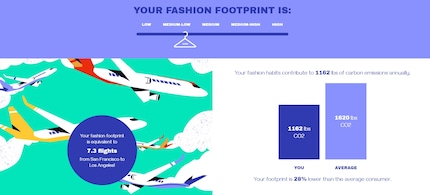
How environmentally friendly is your wardrobe?
The global textile industry takes the second spot when it comes to CO2 emissions. This should shake me up. But I don’t seem to be all that alarmed just yet. Will a «Fashion Footprint Calculator» help?
Shopping in London this weekend and strolling past the boutiques in La Bella Rome next week – not a problem, thanks to cheap plane tickets. Flying has arrived to the masses long ago. This makes it all the more astonishing that the fashion industry has overtaken flying when it comes to environmental pollution. This is to blame on both the manufacturing process of clothing as well as the cultivation and production of their raw materials. You can experience just how negatively your wardrobe influences climate change with the help of the new «Fashion Footprint Calculator» by Thredup, which I’ve tested.
Hold up – what does shewant from me?! Don’t worry, if that’s your first reaction toward a fashion editor, that’s fine! After all, I report on the latest trends and must-haves one day, and then suddenly preach on the dos and don’ts in regards to fashion and climate change. That’s a contradiction if ever I’ve seen one. But the one doesn’t have to rule out the other. You just have to think well about this issue. And because I didn’t reflect on this for far too long, I’m also blaming myself. Correctly separating my waste and declining plastic bags when shopping for my groceries simply doesn’t cut it.
When I heard of the Fashion Footprint Calculator, it piqued my interest. The test has twelve questions about my buying behaviour and is designed to determine my personal CO2 footprint and the number of airplane miles this equals. It takes me five minutes to complete the test and find out that I rank in the «medium-low» segment. I’m quite surprised, as this is more positive than I initially expected. It still, however, motivates me to do something, because there’s a lot of room for improvement. After the analysis, I’m given tips which should help me reduce my future CO2 footprint.

Approaches
One tip is that by buying second-hand fashion, I reduce my CO2 emissions by about 65 per cent. That’s a significant reduction, which is attributable to the lion’s share of CO2 being emitted during the initial phase of clothing production. When you buy second-hand clothes, you skip this step. By the way, the production of jeans is the worst in this respect. That’s why you should especially buy used jeans if possible. If you prefer wearing unworn fashion, it’s best to buy brands with sustainable designs, such as Patagonia and Elephbo.
Buying clothes in brick-and-mortar stores also results in higher CO2 emissions. Although (national) parcel shipping also has a negative effect on the CO2 balance when shopping online, the CO2 balance is comparatively lower because clothes are sent from door to door. If you decide not to use the Express option, you’ve pretty much done everything right. Washing clothes isn’t as harmless as one might think either: try to avoid hot water (the colder the better) and refrain from drying in a tumble dryer.
The magic formula here is quality over quantity. Simply put: shop less and try to invest in first-class, environmentally friendly materials such as Tencel. This small contribution to the environment has great effects – if we all chip in. If you want to find out whether the test positively affected my fashion carbon footprint, just follow me. I’ll let you know in three months whether the test helped me on my way.
When I’m not exploring the depths of the sea as an open water diver, I enjoy plunging into the world of fashion. On the streets of Paris, Milan and New York is where I keep my eyes peeled for the latest trends. And I’ll show you how to take them from the catwalk to your everyday life.
From the latest iPhone to the return of 80s fashion. The editorial team will help you make sense of it all.
Show all